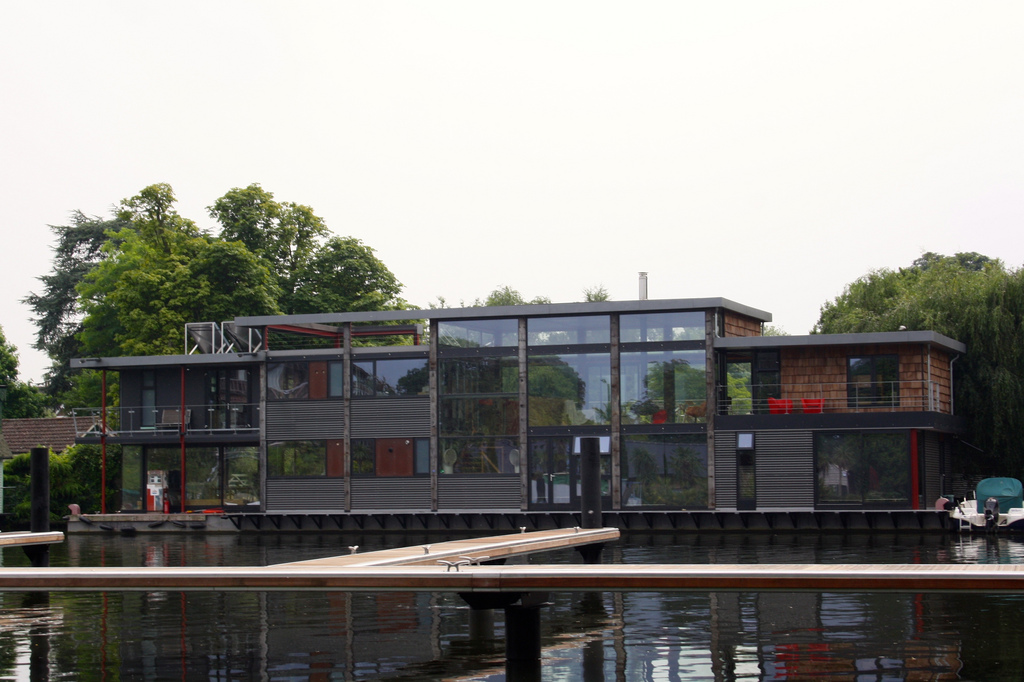by Dorothy Laing
With flood levels finally subsiding, householders and businesses are faced with a mammoth clean-up operation, but with flooding likely to be a regular occurrence due to climate change is it time to think seriously about designing and building flood resilient or amphibious housing?
The government’s recently updated guidance Flood Support Schemes Guidance Note offers advice to local authorities, businesses and homeowners on grants available for flood resilient repairs. These resilience measures (internal modifications intended to reduce the cost of any damage from flood water) include possible features such as waterproofing walls, non-return valves, replacing timber floor with solid concrete, and treating timber to make it water resistant.
The Landscape Institute and other professional organisations, in a recent open letter on water management sent to David Cameron on 17 February, stated that:
“Buildings and land.…should be made resilient to withstand flooding, and we must consider carefully how and where we plan new development, and that all new housing in flood plains must be resilient when built.”
Last year CIRIA, the construction industry research and information association, produced Water sensitive urban design in the UK: ideas for built environment practitioners which outlined the drivers, benefits and vision for Water Sensitive Urban Design (WSUD) in the UK. WSUD is the process of integrating water cycle management with the built environment through planning and urban design. The booklet describes the main features of water sensitive houses and includes diagrams showing what a water-sensitive, housing development and city might look like – incorporating flood resilient housing.
Are floating homes the solution?
Taking things a step further – what about the idea of floating or amphibious development? There are two types of floating homes, permanently floating homes and homes that float only when flood waters swell. These amphibious houses are buildings that rest on the ground on fixed foundations but, whenever a flood occurs, the entire building rises up in its dock and floats, buoyed by the floodwater.
So far the idea of floating homes hasn’t really taken off in Britain, but there are numerous examples of existing floating houses of different designs in other parts of the world, including Germany, Canada, the US, and in the Netherlands where flooding is commonplace and land is at premium. In Maasbommel, along the Maas River, about 60 miles from Amsterdam, amphibious homes have been built on platforms that rest on land but are designed to rise when waters rise. When the river swells the house will float as much as 18 feet and it floats back down as the water subsides. Perhaps the UK could learn from the experience in Maasbommel?
On the Thames floating homes have been around on Taggs Island for over a hundred years. More recently proposals for a new floating development have been put forward in a competition for ideas to turn the Royal Docks in London into a green infrastructure space. The Project Float entry suggests a modular clip-together system comprising deep plastic floating units. These can be used to create islands of varying size which can be then topped with soil and planted, or surfaced for paths or timber buildings. In 2013 planning permission was granted for Britain’s first amphibious house which is to be built in Marlow on the banks of the River Thames. It’s due for completion this year.
Further Information
Ashley, Richard et al Water sensitive urban design: opportunities for the UK, IN Municipal Engineer, Vol 166 No ME2 June 2013, pp65-76
Cooper, Stewart When it all gets too much (flooding), IN Building Control Journal, Apr 2013, pp16-17
Dolma, Nanco; Savage, Amy; Ogunyoye, Fola Water sensitive urban design: learning from experience, IN Municipal Engineer, Vol 166 No ME2 June 2013, pp86-97
Morgan, Celeste; Woods, Ashley Creating a water-sensitive north-west Cambridge master plan, IN Municipal Engineer, Vol 166 No ME2 June 2013, pp98-110
Shaffer, Paul The role of water sensitive urban design in the UK, IN Evolution, Summer 2012, pp24-27
White, I et al (2013) Six steps to flood resilience: guidance for local authorities and professionals. University of Manchester
Share
Related Posts
Supporting residents on the decarbonisation journey: leveraging data for effective retrofit projects
As the drive towards decarbonisation intensifies, the social housing sector’s ability to collect, store and manage vast amounts of data becomes increasingly critical. With a shared goal of creating warmer, carbon-free homes, housing associations’ strategic use of data is essential ....
The recent spikes in energy costs have thrown into sharp focus the challenge of heating our homes. Domestic heating is important, not just for our comfort and wellbeing, but to reduce humidity and prevent condensation. But because traditional heating systems ....
By Ian Babelon A new-old concept for proximity “Are we there yet?” Parents may patiently nod to their children’s insistent nudges on a 20-minute journey to… somewhere. Quite rightly, researchers have asked: twenty minutes to what? The answer may well ....


